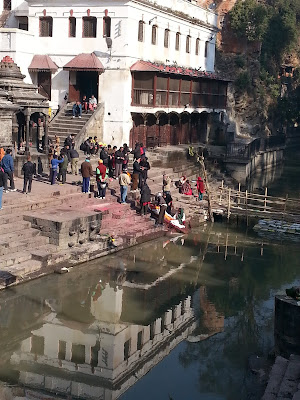It was a crisp Friday morning in December. I was standing on a temple compound in Kathmandu thronged by hundreds of sombre-looking devotees offering prayers with garlands and fruits. The air was scented with a mixture of fragrance from the flowers and incense. The sidewalks were bustling with vendors hawking a wide variety of religious souvenirs and infested with stray dogs scavenging for food through piles of garbage. The place was overrun with wild monkeys. They were running, swinging and jumping everywhere. Occasionally, some of these cheeky primates were seen cautiously inching towards devotees and prodding them in the arm as a gesture of begging for food.
The grounds offered what I expected from a ‘normal’ Nepalese temple – until an ambulance pulled to a stop in front of me, dropping off two burly medical attendants who sprang into immediate action by removing a stretcher with a body wrapped in white sheets, and wheeling it over to the family of the deceased who were grimly waiting for the funeral ceremony to begin. The atmosphere was suddenly shrouded with sadness and gloom, jolting me into a realization that it was not a regular temple. I was, in fact, setting my foot on the famous Pashupatinath Temple where open cremation takes place.
Pashupatinath Temple is a well-known sacred Hindu Temple nestled on the banks of the holy river of Bagmati in Kathmandu Valley. The temple complex is a UNESCO World Heritage Site where Hindus bid their last goodbye to their loved ones in a solemn cremation ceremony. For those who are keen on exploring unique foreign culture or seek exotic spiritual experience, this is the right place to be. A word of warning for the faint-hearted, you might want to omit this from your itinerary if the sight of cremation is too much for your psyche or stomach to handle.
Visitors are welcome to witness the cremation ceremony from the other side of the river. Out of the respect for the deceased, visitors are advised to conduct themselves appropriately during the ceremony. Basic rules to bear in mind: no screaming, laughing, snickering and foul language is strictly prohibited. I joined the eager crowd awaiting the start of the ritual.
With the entire body blanketed in a white sheet, the deceased was laid to rest on a large wooden plank positioned downward on a staircase leading to the river. The grief-stricken family members converged on the riverbank and began the cleansing ritual by repeatedly wiping the lifeless face of the deceased with a wet cloth. Once the cleansing was done for one last time, garlands of flowers were placed around the neck and tilak (sandalwood paste used in Hindu religious ceremonies) was heavily applied on the forehead of the deceased. The body lay peacefully on the riverbank surrounded by the surviving family members who appeared to be drifting into a state of deep mourning.
The body was later transferred to the cremation pyre made up of stacked dry grass. With hands clasped in a prayer, family and friends paid the last tribute to the departed soul by walking in a circle around the body now partially buried by the haystack. One of them, presumably the wife of the deceased, leaned in and planted a long and loving kiss on the feet of the body. Seemingly lost in a trance, she held the kiss for so long that the undertaker had to come over and gently pull her away. Bystanders were moved to tears by the scene.
Soon after, everyone was cleared out of the area before the haystack was torched and gradually engulfed by a thick plume of smoke. The billowing smoke eventually turned into roaring flames ripping through the haystack and incinerating the body to ash.
I left the ceremony with a heavy heart and a new outlook on life. Life is short, it is foolish to spend our lives dwelling on negative thoughts. So let’s carpe diem and seize the day and do not forget to make every breathing moment count.




No comments:
Post a Comment